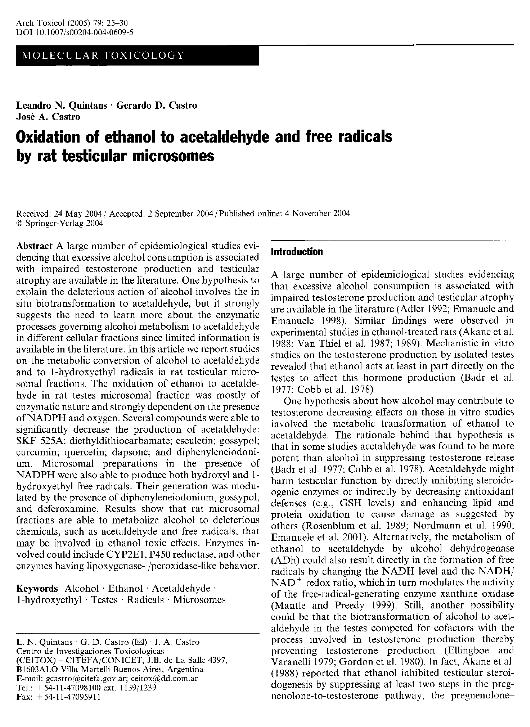Mostrar el registro sencillo del ítem
dc.contributor.author
Quintans, Leandro

dc.contributor.author
Castro, Gerardo Daniel

dc.contributor.author
Castro, Jose Alberto

dc.date.available
2019-08-27T14:57:20Z
dc.date.issued
2005-01
dc.identifier.citation
Quintans, Leandro; Castro, Gerardo Daniel; Castro, Jose Alberto; Oxidation of ethanol to acetaldehyde and free radicals by rat testicular microsomes; Springer; Archives of Toxicology; 79; 1; 1-2005; 25-30
dc.identifier.issn
0340-5761
dc.identifier.uri
http://hdl.handle.net/11336/82214
dc.description.abstract
A large number of epidemiological studies evidencing that excessive alcohol consumption is associated with impaired testosterone production and testicular atrophy are available in the literature. One hypothesis to explain the deleterious action of alcohol involves the in situ biotransformation to acetaldehyde, but it strongly suggests the need to learn more about the enzymatic processes governing alcohol metabolism to acetaldehyde in different cellular fractions since limited information is available in the literature. In this article we report studies on the metabolic conversion of alcohol to acetaldehyde and to 1-hydroxyethyl radicals in rat testicular microsomal fractions. The oxidation of ethanol to acetaldehyde in rat testes microsomal fraction was mostly of enzymatic nature and strongly dependent on the presence of NADPH and oxygen. Several compounds were able to significantly decrease the production of acetaldehyde: SKF 525A; diethyldithiocarbamate; esculetin; gossypol; curcumin; quercetin; dapsone; and diphenyleneiodonium. Microsomal preparations in the presence of NADPH were also able to produce both hydroxyl and 1-hydroxyethyl free radicals. Their generation was modulated by the presence of diphenyleneiodonium, gossypol, and deferoxamine. Results show that rat microsomal fractions are able to metabolize alcohol to deleterious chemicals, such as acetaldehyde and free radicals, that may be involved in ethanol toxic effects. Enzymes involved could include CYP2E1, P450 reductase, and other enzymes having lipoxygenase- /peroxidase-like behavior.
dc.format
application/pdf
dc.language.iso
eng
dc.publisher
Springer

dc.rights
info:eu-repo/semantics/openAccess
dc.rights.uri
https://creativecommons.org/licenses/by-nc-sa/2.5/ar/
dc.subject
1-Hydroxyethyl
dc.subject
Acetaldehyde
dc.subject
Alcohol
dc.subject
Ethanol
dc.subject
Microsomes
dc.subject
Radicals
dc.subject
Testes
dc.subject.classification
Toxicología

dc.subject.classification
Medicina Básica

dc.subject.classification
CIENCIAS MÉDICAS Y DE LA SALUD

dc.title
Oxidation of ethanol to acetaldehyde and free radicals by rat testicular microsomes
dc.type
info:eu-repo/semantics/article
dc.type
info:ar-repo/semantics/artículo
dc.type
info:eu-repo/semantics/publishedVersion
dc.date.updated
2019-08-26T18:12:53Z
dc.journal.volume
79
dc.journal.number
1
dc.journal.pagination
25-30
dc.journal.pais
Alemania

dc.journal.ciudad
Berlin
dc.description.fil
Fil: Quintans, Leandro. Consejo Nacional de Investigaciones Científicas y Técnicas. GP. CITEFA - Centro de Investigaciones Toxicológicas (I); Argentina
dc.description.fil
Fil: Castro, Gerardo Daniel. Consejo Nacional de Investigaciones Científicas y Técnicas. GP. CITEFA - Centro de Investigaciones Toxicológicas (I); Argentina
dc.description.fil
Fil: Castro, Jose Alberto. Consejo Nacional de Investigaciones Científicas y Técnicas. GP. CITEFA - Centro de Investigaciones Toxicológicas (I); Argentina
dc.journal.title
Archives of Toxicology

dc.relation.alternativeid
info:eu-repo/semantics/altIdentifier/url/https://link.springer.com/article/10.1007/s00204-004-0609-5
dc.relation.alternativeid
info:eu-repo/semantics/altIdentifier/doi/https://doi.org/10.1007/s00204-004-0609-5
Archivos asociados
